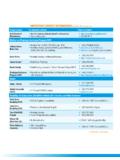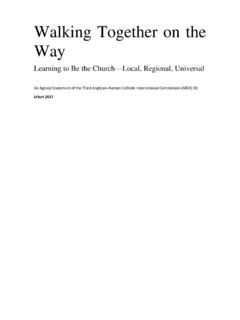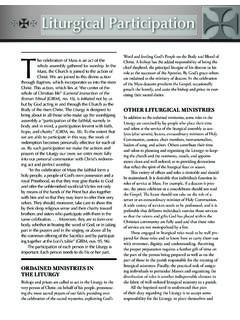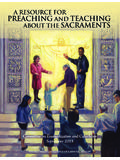Transcription of What Is the Sacred Liturgy - Archdiocese of Philadelphia
1 Liturgical Catechesis No. 1, December 2010 what Is the Sacred Liturgy ? After vatican II, when the word Liturgy sprang into more common usage, its definition (from the Greek leitourgia) the work of the people or work on behalf of the people soon resulted in an emphasis solely on the first, rather than the more important second understanding. Some explain this as a consequence of the Council s call for full, active and conscious participation (SC 2 14) in the worship of the Church as the right and duty of the Christian people, particularly as individuals and the entire assembly gradually assumed a more active role in liturgical celebrations. It is true that, immediately after the liturgical reforms of vatican II, the tendency was to focus on the assembly s role in the celebration of the Liturgy while failing, perhaps, to recognize the more important work of God being accomplished in the assembly s midst.
2 While a better balance in understanding both aspects of the Liturgy now exists, an even greater grasp of what the Church believes and teaches about the Sacred Liturgy will bring forth much fruit for the life of the Church. The Sacred Liturgy is the Church s official public and communal worship. While the celebration of the Eucharist is the Church s principal act of worship, the Liturgy also includes the celebration of the six additional sacraments, the official daily prayer of the Church (the Liturgy of the Hours), and liturgies for special celebrations. As the Church s official worship, each of these liturgies has at its heart the celebration of the Mystery of our Faith that is, the Sacred passion, death and resurrection of Our Lord Jesus Christ. This mystery, known as the Paschal Mystery, is the continuing work of our redemption by Christ and through his Church.
3 vatican II s Constitution on the Sacred Liturgy reminds us that the Old Testament, as the history of God s amazing deeds among the people of Israel, was but a prelude to the work of Christ the Lord in redeeming mankind and giving perfect glory to God (SC 5 2; cf. St. Augustine). By his obedience to the Father s will and plan of salvation and by his redemptive self-sacrifice, Jesus, the new Adam, destroyed the power of sin and death and made possible eternal life. The Gospels tell us that, as he hung upon the cross, there came forth from Jesus wounded side blood and water understood in time as symbolic of the mystery of the Church a mystery made manifest at Pentecost in the outpouring of the Spirit upon the Apostles, witnesses and believers. Filled with the power of the Spirit, they grasped ever more clearly the mystery of Jesus death and resurrection as the way of salvation for all people.
4 In time, leitourgia in the New Testament referred to the participation of early Christians in the work of God, the continuing work of their redemption (Cf. Jn ). While leitourgia also referred at times to the proclamation of the good news and charitable works, it referred particularly to the gathering of small Christian communities for prayer and, especially, for the breaking of the bread (Acts 2: 42). There, at the meal, like the disciples on the road to Emmaus, they knew him as he broke the bread. They recognized him as being wholly present in their midst and continuing in them his redemptive work of Calvary. Held as Sacred by the Church through the ages, the Sacred Liturgy is understood as an exercise of the priestly office of Jesus Christ (SC 7 2-3). It is he who, as both victim and priest, continues his self-offering to the Father, interceding on our behalf at every Liturgy .
5 It is he, as head of his body the Church, his Mystical Body on earth, who makes present in the midst of the assembly his work of redemption. It is he who also joins to his eternal sacrifice the humble self-offering of the gathered faithful. And it is through him, with him, and in him that our grateful praise and thanksgiving reach the Father in the power of the Spirit. The Liturgy is, then, our participation in Jesus prayer, in his obedience and self-offering to the Father. Through that participation, the Liturgy becomes our work, the work of the Church. For this reason the Constitution on the Liturgy says that every liturgical celebration is a Sacred action surpassing all others. No other action of the Church can equal its efficacy (SC 7 2-3). Thus, the Church to this day proclaims, celebrates and rejoices in the saving work of Jesus Christ the Paschal Mystery which is made present principally in the Mass, but also in all liturgical celebrations.
6 We, as Catholics, must understand every liturgical celebration first and foremost as the work of God through, with, and in Jesus Christ; it is his saving work for us and in us, and only then can we understand it as our work of responding with praise, thanksgiving, supplication and fidelity. This understanding is, with the Spirit s help, the way to a deeper experience of a most profound mystery of our faith. Reflection Questions: 1. The Church s Constitution on the Sacred Liturgy tells us that full active and conscious participation in the Liturgy is a right and duty of the Christian people. How and why do we have the right to participate in Christ s redemptive action? Why is it our duty to do so? 2. In the Mass Christ joins our own self-offering to His own eternal offering to the Father.
7 what makes up your self-offering? what aspects of your self are offered, and how can that self-offering be lived out in your life? 3. The Liturgy celebrates the Paschal Mystery. How does participation in the Sacred Liturgy call you to a more profound conversion to Christ? Prayer: Heavenly Father, We thank you for the precious gift of the Sacred Liturgy , in which we participate in Christ s own perfect and acceptable sacrifice. We pray that through our participation in the Liturgy we will be more closely united to your Son, through whom all blessing and redemption come. We ask this through Christ our Lord. Amen.








